organic chemistry lab manual
An organic chemistry lab manual is an essential resource for students, providing detailed procedures, safety protocols, and best practices for conducting experiments. It covers fundamental techniques such as crystallization, distillation, and chromatography, ensuring a comprehensive understanding of laboratory methods and green chemistry principles to enhance practical skills and safety awareness.
Importance of Lab Manuals in Organic Chemistry
A lab manual is a cornerstone of organic chemistry education, offering clear, step-by-step procedures for experiments and ensuring safety. It provides essential techniques, such as crystallization and distillation, and serves as a reference for troubleshooting. By detailing proper waste disposal and emergency procedures, it fosters a safe learning environment. Additionally, lab manuals like Vogel’s and Armarego’s guide students in purifying chemicals, which is vital for labs with limited resources. They also introduce green chemistry principles, promoting sustainable practices. Overall, a well-structured lab manual enhances practical skills, reinforces theoretical concepts, and prepares students for advanced research, making it indispensable for success in organic chemistry labs.
Key Features of a Comprehensive Lab Manual

A comprehensive lab manual for organic chemistry includes detailed procedures for experiments, such as crystallization and distillation, along with safety protocols and waste disposal guidelines. It features clear diagrams and workflows to set up equipment, like those in Gilbert and Martin’s manual, ensuring students understand each step. The manual also covers green chemistry principles, promoting eco-friendly practices. Additional resources like theory sections, troubleshooting tips, and exercises enhance learning. Many manuals, such as Zubrick’s Survival Manual, offer practical hints and historical context, making complex techniques accessible. These features collectively provide a structured and informative guide, essential for mastering organic chemistry lab skills and fostering a safe, efficient, and environmentally conscious laboratory environment.
How to Effectively Use an Organic Chemistry Lab Manual
To effectively use an organic chemistry lab manual, start by thoroughly reviewing the procedures and safety guidelines before each experiment. Pay attention to detailed diagrams and workflows, such as those in Gilbert and Martin’s manual, to understand equipment setup and techniques. Take notes on key steps and potential hazards, and refer to additional resources like online tutorials for clarification. Plan ahead by organizing materials and scheduling time for data collection and analysis. Regularly update your lab notebook with observations and results, ensuring accuracy for report writing. Utilize troubleshooting sections, like those in Zubrick’s manual, to address common issues. By following these steps, you can maximize learning, safety, and efficiency in the lab, making the manual an indispensable tool for success in organic chemistry.
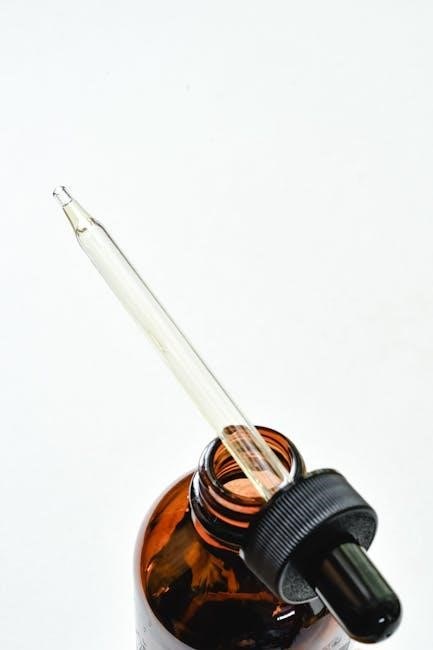
Safety Protocols in the Organic Chemistry Lab
Safety protocols in the organic chemistry lab are crucial for protecting students and equipment. Adhere to guidelines, use personal protective equipment, ensure proper waste disposal, and understand emergency procedures to ensure a safe and successful laboratory experience.
General Safety Guidelines
General safety guidelines in an organic chemistry lab are essential to prevent accidents and ensure a secure working environment. Always wear appropriate personal protective equipment (PPE), including gloves, goggles, and lab coats. Familiarize yourself with the Material Safety Data Sheets (MSDS) for all chemicals used. Ensure proper ventilation and avoid inhaling fumes or vapors. Never taste or smell chemicals, and handle hazardous materials with care. Keep long hair and loose clothing tied back, and avoid wearing open-toed shoes. Understand the location and proper use of safety equipment, such as fire extinguishers, eyewash stations, and emergency showers. Follow all posted safety signs and instructions from instructors. Maintain a clean and organized workspace to minimize risks and ensure smooth operations.
Handling Hazardous Chemicals
Handling hazardous chemicals in an organic chemistry lab requires strict adherence to safety protocols to minimize risks. Always wear appropriate personal protective equipment (PPE), including gloves, goggles, and lab coats, when working with hazardous substances. Use secondary containment, such as trays or pans, to prevent spills from spreading. Consult the Material Safety Data Sheets (MSDS) for specific handling instructions and toxicity information. Ensure proper ventilation by working in a fume hood when dealing with volatile or toxic chemicals. Avoid skin contact and inhalation of vapors. Use tongs or gloves to handle broken glassware contaminated with hazardous substances. Dispose of chemicals according to established guidelines and decontaminate equipment thoroughly after use; Always follow the lab instructor’s guidance and posted safety procedures to ensure safe handling and minimize potential hazards.
Proper Waste Disposal Techniques
Proper waste disposal is critical in an organic chemistry lab to prevent environmental contamination and ensure safety. Segregate waste into organic, inorganic, and hazardous categories, using designated containers for each type. Dispose of hazardous chemicals according to local and institutional guidelines, ensuring compliance with environmental regulations. Use sealed containers for hazardous waste and label them clearly. Broken glassware contaminated with chemicals should be placed in separate, puncture-resistant bins. Never dispose of chemicals down drains or in regular trash. Decontaminate equipment before disposal whenever possible. Adhere to specific protocols for disposing of reactive or flammable materials, and consult the lab manual or instructor for guidance. Proper waste management protects both people and the environment, maintaining a safe and responsible laboratory environment.
Emergency Procedures
In case of an emergency in the organic chemistry lab, it is crucial to act swiftly and follow established protocols. For fires, use a fire extinguisher rated for chemical fires, and evacuate the area if the situation becomes unmanageable. In the event of a chemical spill, contain the area, wear protective gear, and neutralize the spill with appropriate materials. If skin or eye exposure occurs, immediately flush with water for at least 15 minutes and seek medical attention. Know the location of emergency exits, fire extinguishers, and eyewash stations. Familiarize yourself with the lab’s emergency contact list and procedures for evacuations. Regular drills and knowledge of these protocols ensure a safe and prompt response to any incident, minimizing risks and protecting everyone in the lab environment.
Essential Techniques in Organic Chemistry Labs

Crystallization, distillation, extraction, and chromatography are fundamental techniques in organic chemistry labs, enabling purification, separation, and identification of compounds. These methods are crucial for successful experiments and data analysis.

Crystallization and Recrystallization
Crystallization and recrystallization are essential purification techniques in organic chemistry labs. Crystallization involves dissolving a compound in a hot solvent and allowing it to cool, enabling pure crystals to form. Recrystallization refines this process by redissolving impure crystals in a minimal amount of hot solvent and repeating the cooling process. These methods are critical for obtaining pure organic compounds, as they effectively separate substances based on solubility differences. Proper techniques, such as slow cooling and avoiding impurities, ensure high yields of pure products. These processes are fundamental for mastering purification in organic chemistry, making them indispensable skills for lab success.
Distillation Methods
Distillation is a fundamental purification technique in organic chemistry labs, used to separate compounds based on their boiling points. Simple distillation is effective for substances with significant boiling point differences, while fractional distillation is used for mixtures with closer boiling points, employing a fractionating column. Vacuum distillation is applied to heat-sensitive compounds, reducing boiling points to prevent decomposition. These methods are crucial for isolating pure organic compounds, especially liquids. Proper setup, including a condenser and collection apparatus, is essential to ensure safe and efficient separation. Regular monitoring of temperature and pressure is necessary to achieve optimal results and avoid contamination. Mastering distillation techniques is vital for successful organic chemistry experiments.
Extraction and Separation Techniques
Extraction and separation techniques are critical in organic chemistry labs for isolating desired compounds from mixtures. Liquid-liquid extraction is commonly used to separate substances based on their solubility in immiscible solvents, such as water and an organic solvent. Solid-phase extraction involves passing a mixture through a solid material that selectively retains certain compounds. These methods are essential for purifying products and removing impurities. Factors like solvent polarity, pH, and temperature significantly influence extraction efficiency. Proper technique ensures high purity of the extracted compound, making these methods indispensable in organic synthesis and analysis. Regular practice and understanding of these principles are vital for mastering separation processes in the lab.
Chromatography Basics
Chromatography is a fundamental technique in organic chemistry labs for separating and analyzing mixtures of compounds. Thin-layer chromatography (TLC) is commonly used to monitor reaction progress and purity, while column chromatography is employed for larger-scale separations. Both methods rely on the differential migration of compounds between a stationary phase and a mobile phase. Gas chromatography (GC) is another widely used method, particularly for volatile compounds, offering precise separation and quantification. Understanding chromatography basics is crucial for optimizing separations, identifying unknowns, and ensuring high-purity products; Regular practice and familiarity with chromatographic principles enhance efficiency in organic synthesis and analysis, making it an indispensable skill in the lab.
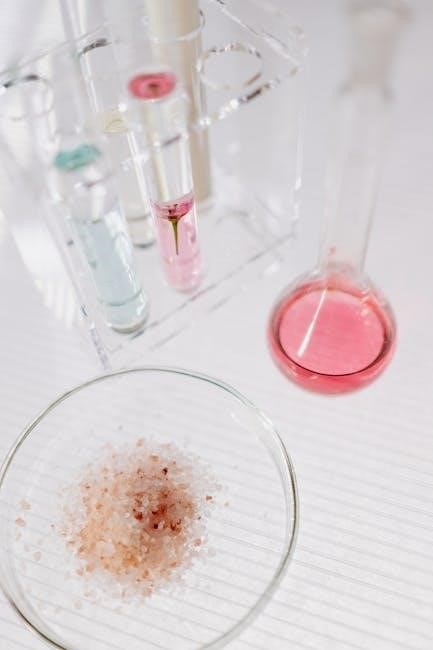
Common Organic Chemistry Lab Experiments
Common experiments include the synthesis of organic compounds, identification of unknown substances, green chemistry practices, and quantitative analysis techniques, providing hands-on experience with fundamental reactions and methods.
Synthesis of Organic Compounds
The synthesis of organic compounds is a cornerstone of lab experiments, focusing on creating substances like carboxylic acids, esters, and amides. These exercises emphasize understanding reaction mechanisms, stoichiometry, and purification methods. Students learn to design and execute multi-step syntheses, applying green chemistry principles to minimize waste. Techniques such as crystallization and distillation are often employed to isolate and purify products. These experiments provide practical insights into how organic molecules are constructed and modified, reinforcing theoretical concepts. By performing these syntheses, students gain hands-on experience with laboratory equipment and develop problem-solving skills to optimize reaction conditions and yields.
Identification of Unknown Organic Compounds
Identifying unknown organic compounds is a critical skill in lab work, involving techniques like boiling point determination, density measurement, and solubility testing. Students use chemical tests such as Chromic Acid and Ferric Chloride to identify functional groups. These methods help determine properties like pH and reactivity, narrowing down possible compounds. Lab manuals often guide this process, emphasizing systematic data collection and analysis. By combining physical and chemical data, students can accurately identify unknown substances, enhancing their understanding of organic chemistry principles and analytical skills.
Green Chemistry Experiments
Green chemistry experiments are a key component of modern organic chemistry lab manuals, focusing on sustainable practices to minimize environmental impact. These experiments emphasize the use of eco-friendly reagents, reduced solvent consumption, and energy-efficient methods. Students learn to design reactions that produce less waste and avoid hazardous chemicals, aligning with green chemistry principles. Techniques such as solvent-free reactions, catalytic methods, and biocatalysis are often highlighted. These experiments not only teach environmental responsibility but also encourage innovative thinking in chemical synthesis. By integrating green chemistry into lab work, students gain practical skills in sustainable practices, preparing them for future challenges in chemistry and related fields;
Quantitative Analysis Techniques
Quantitative analysis techniques are crucial in organic chemistry labs for determining the purity, concentration, and yield of compounds. Methods like chromatography, titration, and spectroscopy are commonly used to analyze samples. Chromatography separates and quantifies components, while titration measures the concentration of a substance. Spectroscopic techniques, such as UV-Vis and IR, provide structural and quantitative information. These methods are essential for verifying the success of syntheses and identifying unknown compounds. Students learn to apply statistical methods to ensure data accuracy and precision. Quantitative analysis is integral to lab reports, enabling the evaluation of reaction efficiency and the validation of experimental results. Mastery of these techniques is vital for advancing in organic chemistry and conducting rigorous scientific investigations.

Lab Reports and Data Analysis
Lab reports document experimental procedures, results, and conclusions, ensuring clarity and reproducibility. Data analysis involves interpreting and presenting findings accurately, using statistical tools to validate results and identify trends.
Structure of a Lab Report
provides background information and the objective of the experiment. Materials and Methods detail the chemicals, equipment, and procedures used. The Results section presents data, often through tables, graphs, or observations. The Discussion interprets the results, explaining their significance and comparing them to expected outcomes. Finally, the Conclusion summarizes the findings and their implications. Proper formatting and clarity are essential to ensure the report is understandable and reproducible.
Interpreting and Presenting Data
Interpreting and presenting data in an organic chemistry lab report requires accuracy and clarity. Data should be analyzed to determine trends, confirm hypotheses, or identify anomalies. Results are often presented using graphs, tables, or images, such as chromatograms or spectra. Proper labeling, units, and legends are essential for clear communication. When interpreting, focus on the significance of the data, comparing it to expected outcomes or literature values. Common techniques include calculating percent yield, determining melting points, or analyzing spectral data. Ensure that conclusions are supported by the data and avoid speculative statements. Best practices include double-checking calculations and using precise language to convey findings effectively.
Common Mistakes to Avoid
Common mistakes in organic chemistry labs include improper use of equipment, inaccurate measurements, and poor record-keeping. Students often overlook safety protocols, such as not wearing PPE or improperly handling hazardous chemicals. Rushing experiments can lead to incomplete reactions or contaminated samples. Additionally, neglecting to double-check calculations or mislabeling compounds can result in erroneous data. Properly following procedures, maintaining a clean workspace, and paying attention to detail are crucial. Regularly reviewing lab handouts and seeking clarification on unclear steps can help minimize errors. Developing good habits, such as thorough note-taking and adherence to safety guidelines, ensures a more efficient and successful lab experience.
Recommended Resources and References
Key resources include Vogel’s Practical Organic Chemistry, Purification of Laboratory Chemicals by Armarego, and The Organic Chem Lab Survival Manual by Zubrick. These texts provide essential techniques, safety tips, and practical insights for organic chemistry labs.
Textbooks for Organic Chemistry Labs
Essential textbooks for organic chemistry labs include Vogel’s Practical Organic Chemistry, a comprehensive guide with detailed procedures, and Purification of Laboratory Chemicals by Armarego, ideal for labs on a budget. The Organic Chem Lab Survival Manual by Zubrick offers practical advice and techniques, while Experimental Organic Chemistry by Gilbert and Martin provides modern approaches with clear diagrams; These textbooks are invaluable for understanding fundamental techniques, safety protocols, and experimental design. They cater to both students and researchers, ensuring a solid foundation in organic chemistry laboratory practices. Additional notable resources include The Synthetic Organic Chemist’s Companion and A Guide for the Perplexed Organic Experimentalist, which offer specialized insights and historical context.
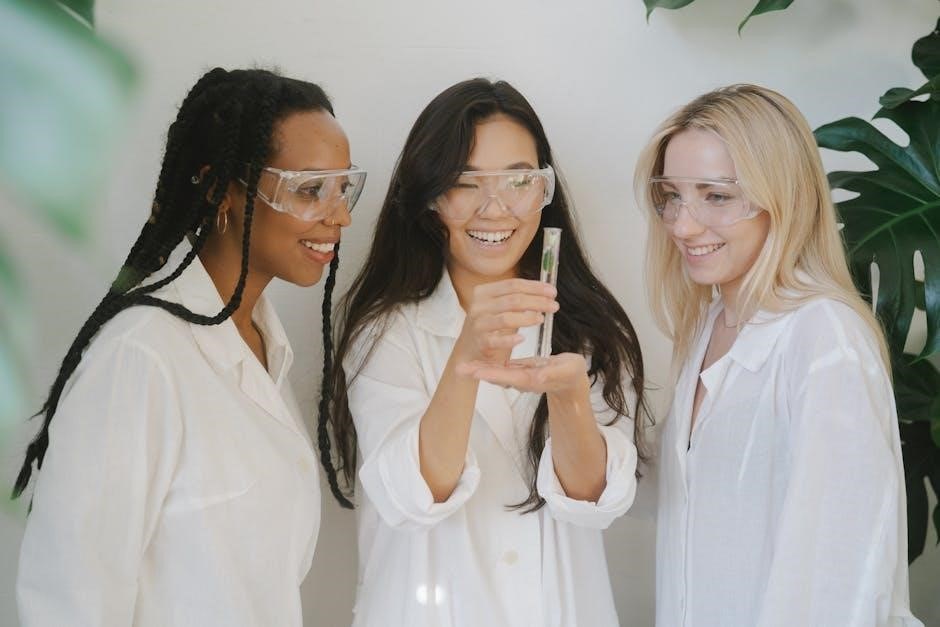
Online Resources and Tutorials
Online resources and tutorials complement traditional lab manuals, offering interactive learning experiences. Websites like Khan Academy and Coursera provide video tutorials on organic chemistry techniques. Platforms such as Mastering Chemistry and Labster offer virtual lab simulations, enabling students to practice procedures in a risk-free environment. Additionally, university websites, such as CSUB’s Organic Chemistry Lab Manual, often publish updated procedures and safety guidelines. Online forums and communities, like Reddit’s r/chemistry, allow students to discuss challenges and share tips. These resources enhance understanding, improve practical skills, and ensure safety in the lab. They are invaluable for students seeking additional support or flexible learning opportunities beyond traditional textbooks and manuals.
Lab Manuals and Guides
Premium lab manuals and guides are indispensable for mastering organic chemistry techniques. Textbooks like Vogel’s Practical Organic Chemistry and Purification of Laboratory Chemicals by Armarego are staples, offering detailed procedures and purification methods. The Organic Chem Lab Survival Manual by Zubrick provides practical advice and troubleshooting tips. Many universities, such as CSUB, publish their own updated lab manuals for specific courses like CHEM 3310 and 3311. These guides often include experiments, safety protocols, and equipment setups, ensuring students are well-prepared. They also emphasize green chemistry and modern approaches, making them essential for both foundational learning and advanced experimentation in organic chemistry labs.
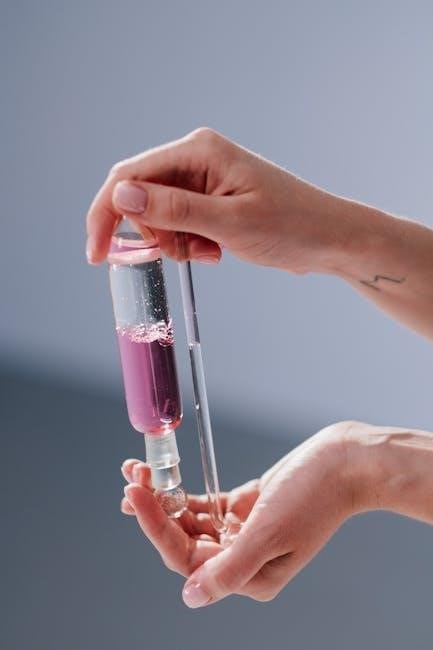
Best Practices for Success in the Lab
Effective time management, staying organized, and active collaboration with peers are key to success. Regularly review procedures, plan ahead for lab reports, and seek help when needed to ensure efficiency and accuracy in experiments.
Time Management and Organization
Effective time management and organization are crucial for success in an organic chemistry lab. Prioritize tasks, create a schedule, and allocate specific time blocks for experiments, data analysis, and report writing. Use digital calendars or planners to track deadlines and set reminders for upcoming assignments. Maintain a well-organized lab notebook, ensuring all data is recorded accurately and promptly. Keep your workspace tidy to avoid wasting time searching for materials. Plan ahead for lab reports, as they often require detailed analysis and can be time-consuming. By staying organized and managing time wisely, you can efficiently complete experiments, meet deadlines, and reduce stress, ultimately enhancing your overall lab experience.
Effective Collaboration
Effective collaboration is vital in an organic chemistry lab, where teamwork often enhances learning and problem-solving. Communicate clearly with lab partners, assigning roles to ensure tasks are divided fairly and efficiently. Share insights and discuss observations to gain a deeper understanding of experiments. Regularly check-in with your team to monitor progress and address challenges promptly. Encourage open dialogue to resolve disagreements and maintain a positive working environment. Collaborative efforts not only improve productivity but also foster a sense of accountability and mutual respect. By working together seamlessly, you can achieve better experimental outcomes and develop strong interpersonal skills, which are essential for success in both academic and professional settings.
Troubleshooting Common Issues
In organic chemistry labs, common issues like impurities in crystallization or inconsistent distillation results often arise. To address these, identify the root cause by reviewing procedures and equipment setup. For crystallization, check solubility and cooling rates, while for distillation, ensure proper heating and fractionation. Consult lab manuals or instructors for guidance, as minor adjustments can resolve many problems. Regularly maintaining and calibrating equipment prevents recurring issues. Additionally, refer to textbooks like Vogel’s or Armarego’s for purification techniques. Documenting observations and seeking feedback from peers or TAs can also provide valuable insights. By systematically troubleshooting, students can refine their techniques and achieve better experimental outcomes, fostering a deeper understanding of organic chemistry principles and practices.
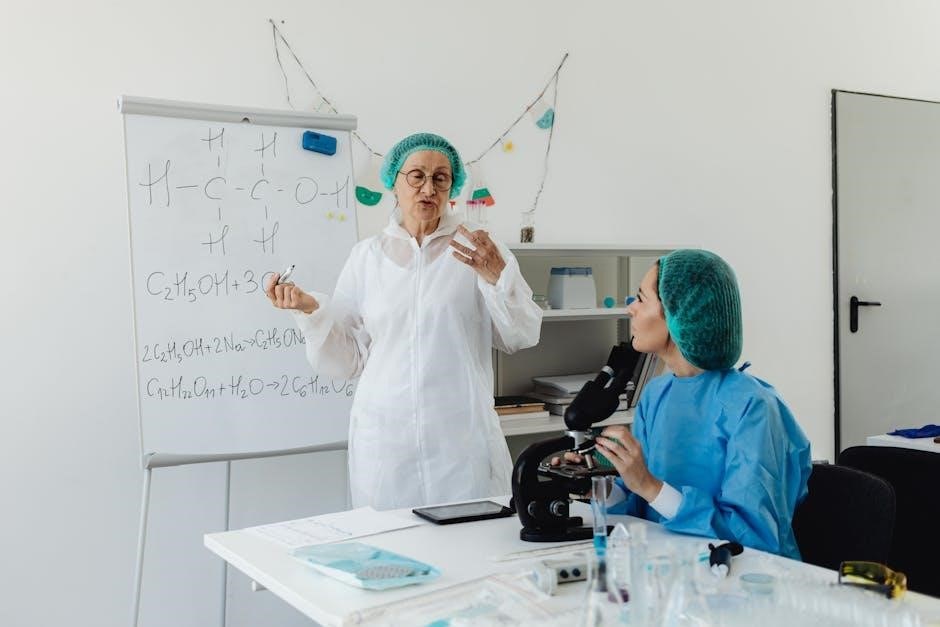









Leave a Comment